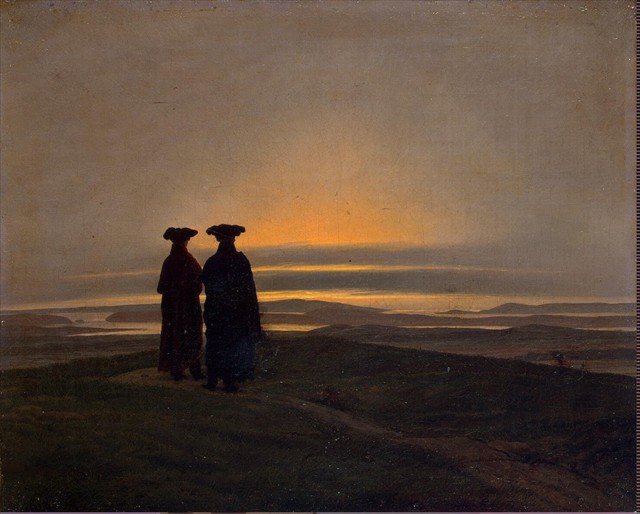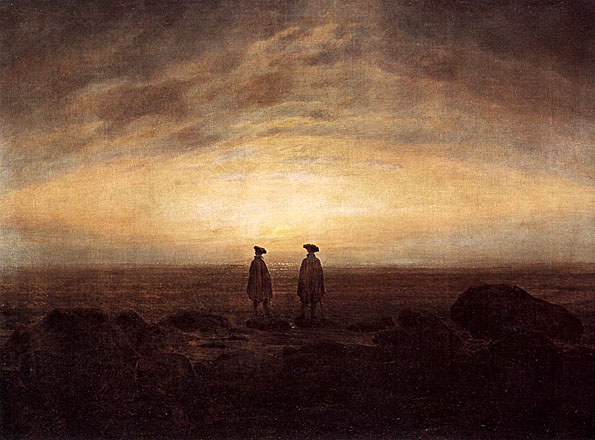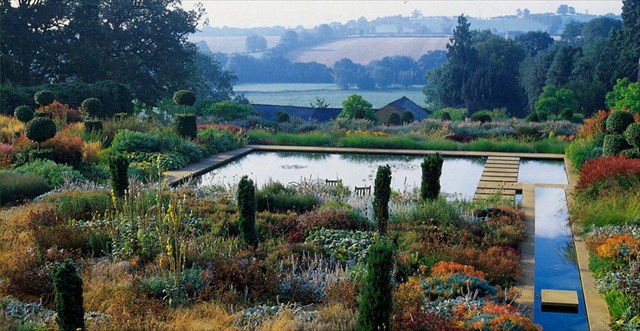On my way home ... after a Tom Stuart-Smith Lecture

This is sunset on Thursday as I drove through the Rosemont Valley nearing my home and garden in the country. It called to mind an image Tom Stuart-Smith briefly showed in his lecture at the New York Botanical Garden earlier in the day.I've passionately admired Tom's gardens since I first saw them (unfortunately only in photos). Though I think his work is among the best there is, I wasn't expecting much, lectures usually being disappointing rehashes of things I already know. I was entirely wrong in this case. His two hour talk was an intense experience of nonstop discovery and exhilaration.The image he flashed on the screen, literally for no more than two seconds, was a Caspar David Friedrich Ruekenfigur. I'm not certain if it was this one ... ... it may have been this, or another.
... it may have been this, or another. He showed the Ruekenfigur (literally "back image"), a human figure, always unidentified, facial features invisible, looking away toward a landscape, to illustrate an important principle of his design approach: a garden should link to its landscape. (He also mentioned an early infatuation with German Romanticism; I believe something of that still permeates his work, thus the Ruekenfigur reference.)In the past few months, I had read Caspar David Friedrich and the Subject of Landscape by Joseph Leo Koerner--an astonishing tour de force, a "reading" of Caspar David Friedrich's work--so seeing the Ruekenfigur, though only for a couple of seconds, drove his point powerfully home. I felt it as shock, almost like a punch in the gut. In that instant I grasped the significance of the view out, the way out, of refuge and prospect (Tom also referred to this). The concept of a garden linking to landscape is nothing new, but Tom's description of this, using a series of images and archetypal metaphors, conveyed something very deeply felt, something far more than simple visual openness to the surrounding terrain. You see this over and over in Tom's work, and it has deep historical roots as well, in Italian Renaissance gardens, for example, in nature, in vanishing aspects of the natural landscape. I don't think I'll ever see a Tom Stuart-Smith garden in the same way again.His client originally wanted this North Oxfordshire garden (below) to be enclosed inside a wall. Tom convinced the client the garden should connect with the landscape and take advantage of the view. So the garden is designed as a series of steps, each level different, dropping down to reveal the countryside.
He showed the Ruekenfigur (literally "back image"), a human figure, always unidentified, facial features invisible, looking away toward a landscape, to illustrate an important principle of his design approach: a garden should link to its landscape. (He also mentioned an early infatuation with German Romanticism; I believe something of that still permeates his work, thus the Ruekenfigur reference.)In the past few months, I had read Caspar David Friedrich and the Subject of Landscape by Joseph Leo Koerner--an astonishing tour de force, a "reading" of Caspar David Friedrich's work--so seeing the Ruekenfigur, though only for a couple of seconds, drove his point powerfully home. I felt it as shock, almost like a punch in the gut. In that instant I grasped the significance of the view out, the way out, of refuge and prospect (Tom also referred to this). The concept of a garden linking to landscape is nothing new, but Tom's description of this, using a series of images and archetypal metaphors, conveyed something very deeply felt, something far more than simple visual openness to the surrounding terrain. You see this over and over in Tom's work, and it has deep historical roots as well, in Italian Renaissance gardens, for example, in nature, in vanishing aspects of the natural landscape. I don't think I'll ever see a Tom Stuart-Smith garden in the same way again.His client originally wanted this North Oxfordshire garden (below) to be enclosed inside a wall. Tom convinced the client the garden should connect with the landscape and take advantage of the view. So the garden is designed as a series of steps, each level different, dropping down to reveal the countryside. I think it's not going too far to see echoes of the Ruekenfigur in the vertical beech topiaries and yews, their backs turned forever toward the viewer, looking out into the landscape.The title of the lecture was The Modern Garden: Finding a Language, and there was much more in it than I've touched on here. I've taken a small piece of the talk, one mentioned only in passing, as I said, because it happened to be evoked by that Rosemont sunset I saw on my way home. But in retrospect, the Ruekenfigur seems to be a very important sign post to a central theme in his gardens, the engagement not only with the landscape, but also with the larger world of culture and history and the living of every day.(The last image is from Tom Stuart-Smith's website where you can see many examples of his extraordinary work.)
I think it's not going too far to see echoes of the Ruekenfigur in the vertical beech topiaries and yews, their backs turned forever toward the viewer, looking out into the landscape.The title of the lecture was The Modern Garden: Finding a Language, and there was much more in it than I've touched on here. I've taken a small piece of the talk, one mentioned only in passing, as I said, because it happened to be evoked by that Rosemont sunset I saw on my way home. But in retrospect, the Ruekenfigur seems to be a very important sign post to a central theme in his gardens, the engagement not only with the landscape, but also with the larger world of culture and history and the living of every day.(The last image is from Tom Stuart-Smith's website where you can see many examples of his extraordinary work.)
